Thanks to increasing media coverage and a boom in resident participation over the past month, a more balanced onslaught of concerned individuals are bringing informed opinions to the New Orleans noise ordinance discussion. This week, audiologist and chief “safe sound” consultant to the New Orleans Musicians Clinic and New Orleans Musicians Assistance Foundation, Dr. Marshall Chasin, chimes in.

Hundreds gather at New Orleans City Hall to protest the “Seven Essentials” noise ordinance proposal on January 17, 2014. (Photo: Ryan Hodgson-Rigsbee)
While the only comprehensive analysis to date of the New Orleans soundscape, and the present noise ordinance on the books, has come by way of Oxford Acoustics professional Dave Woolworth’s commissioned report, other sound scientists are now beginning to weigh in.
After reviewing information on the (formerly) proposed “Seven Essentials” New Orleans noise ordinance (brought forth by the VCPORA organization) that the New Orleans City Council signed onto as the base draft for the revised noise ordinance on December 19, 2013 (and then formally withdrawn on January 17, 2014,) as well as other related documentation pertaining to the sound ordinance issue, Dr. Chasin has begun to draft his professional opinion on the matter. Today, he offers OffBeat the opportunity to share his educated and experienced thoughts surrounding the topic. His complete letter, without omission or edit, is below.
BIG BROTHER LIVES IN NEW ORLEANS
By: Marshall Chasin, AuD., Doctor of Audiology M.Sc., Reg. CASLPO
Recipient of the 2012 Queen Elizabeth II Diamond Jubilee Medal
Recipient of the 2013 Jos Millar Shield (British Society of Audiology)
The blog to follow this post will be posted on Feb 4, 2014 on www.HearingHealthMatters.org/HearTheMusic.
The New Orleans City Council and Mayor Mitch Landrieu have decreed that no toilets can be flushed in New Orleans; no telephones can be used; no conversations can be held in an environment where there are more than 4 people talking; and no music can be played in excess of 70 dB. This is the motion that is behind a new proposed by-law that is before the city council in New Orleans.
Specifically the old New Orleans by-law of action at 80 dB (presumably 80 dBA?) is currently being considered to be changed to 70 dB.
Before getting in to the silliness that is now before the New Orleans city council, let’s review what 70 dB means. I will assume that “70 dB” means 70 dBA and not 70 dB peak. If it is 70 dB “peak” then legally people of New Orleans will only be allowed to whisper and never drive cars with internal combustion engines.
● Average conversational speech by one person at 1 meter is 60-65 dBA
● Average conversational speech by 4 people talking at 1 meter is about 70dBA
● A toilet flushing is 77d BA (and with your head in the bowl, it is 85 dBA)
● A telephone dial tone on a land line (and speech on the telephone) is about 84 dBA.
● The sound of an ocean wave hitting a beach is about 70-75 dBA.
In short, the New Orleans City Council is considering outlawing all of these sounds. If this new by-law is passed, phones will be outlawed, toilets cannot be flushed, and groups of more than 4 people will not be able to legally congregate- well they can, but only 1 or 2 will be able to talk at the same time. And oh yes, all beaches will need to be closed.
To be fair, the City Council did commission a study by Dave Woolworth near the end of 2012 and the study was presented to Council in August 2013. It suggested that “in the French Quarter and Bourbon Street in particular, noise be capped somewhere between 90 and 100 decibels, measured at the open doors and windows of venues.” This is very reasonable and is consistent with the noise by-laws found in other parts of the world. The 70 dBA proposed by-law is inconsistent with reality.
I tried playing my clarinet (it was Mozart) and even when played very softly, the output was far in excess of 70 dBA. I then asked my son to strum his acoustic classical guitar- well, that would be outlawed in New Orleans as well. And of course, we would not be able to sing along with his guitar music- that would be over 70 dB as well.
I would still urge all readers to visit beautiful New Orleans- it is a wonderful city- but when there, if this by-law does pass, you will not legally be able to drive or talk to anyone, and of could you will not be able to flush the toilet (or for that matter, use running water to wash your hands). Some of this has been sourced from an article by Michael Patrick Welsh entitled “The Music Lover’s Guide to the New Orleans Election.”
On a more serious tone, this is a very complex situation. Clearly having a city by-law where action is deemed to be necessary at 70 dBA is silly, but the solutions are not always obvious. A balance is needed between the music levels and the listeners, the music levels and the bystanders on the street (who don’t want to necessarily listen to the music), and the hearing health of the musicians other club personnel as well.
On Monday January 27, 2014, there was a special meeting of the Housing and Human Needs Committee of the city of New Orleans and there were many public depositions regarding this issue. For those who like to listen to three-hour meetings, a video can be found here. There were depositions from musicians, musician union representatives, local residents, and health professionals. If you only want to listen to several minutes of this meeting, I suggest that you go to time counter 01:18:58 and listen to what John Moore has to say. John is affectionately referred to as Deacon John and he is the president of the New Orleans Musicians’ Union. Deacon John provides us with a balanced voice of reason that many cities can learn from.
This several minute portion of the tape (starting at 01:18:58) should be required material in any graduate audiology program course on noise and its effects.
Dr. Chasin’s resume is not to be scoffed at: He is one of the crafters of The New Orleans Musicians’ Clinic Practice Safe Sounds Initiative. He is the Director of Auditory Research at the Musicians’ Clinics of Canada in Toronto, the Coordinator of Research at the Canadian Hearing Society, and the Director of Research at ListenUp Canada. He received his bachelors in Mathematics and Linguistics at the University of Toronto. He is an Associate Professor in the School of Communication Sciences & Disorders, Faculty of Health Sciences (Audiology) at the University of Western Ontario, Adjunct Research Fellow at SUNY at Buffalo, and Adjunct Professor at the University of Toronto (in Linguistics) specializing in Acoustic Phonetics. Chasin has been involved with hearing and hearing aid assessment since 1981, having graduated with an M.Sc. from the University of British Columbia, and is the author of over 150 clinically based articles. In 2003, he obtained his AuD from the Arizona School of Health Sciences. Marshall has lectured internationally on music and noise exposure.
For a recap of the January 27 City Council special committee hearing, click here.
WHAT YOU MAY HAVE MISSED
Several hundred musicians, venue owners and other residents opposed to the “Seven Essentials” proposed noise ordinance draft rallied to protest its signing by City Council and demand its withdrawal from public record on Friday, January 17 at New Orleans City Hall. Glen David Andrews led the second line from Duncan Plaza into the City Council chambers where only one City Council member, LaToya Cantrell (District B), was present to hear the citizens’ formal comments on the noise ordinance draft.
New Orleans photographer Ryan Hodgson-Rigsbee was on-site to photo-document the event. View his photoset from the rally and City Council hearing below…

Several hundred New Orleans musicians, venue owners and other residents question Council woman LaToya Cantrell about the “Seven Essentials” noise ordinance draft, demand its withdrawal. (Photo: Ryan Hodgson-Rigsbee)
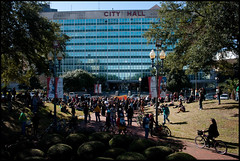
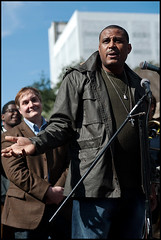
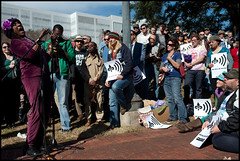

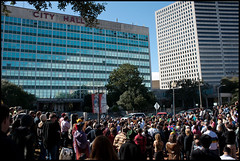
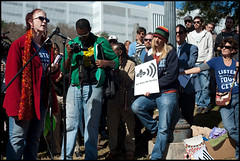
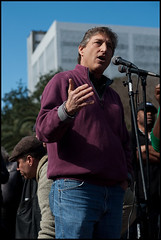
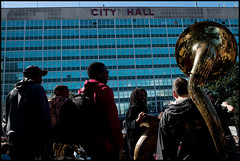
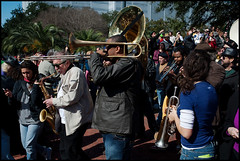
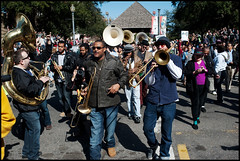

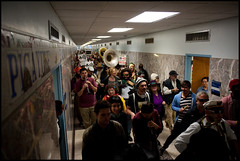
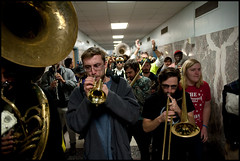
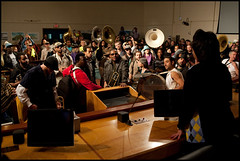
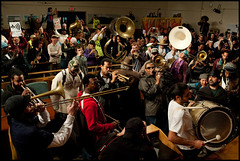
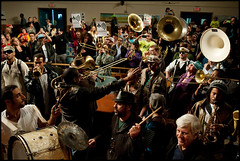
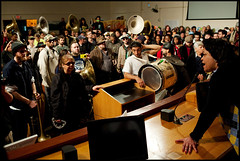
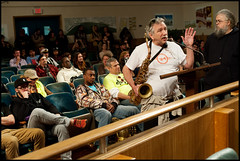
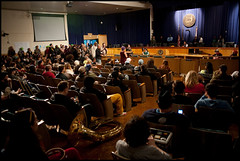
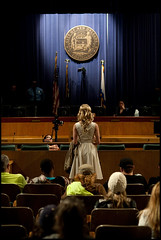
All photos courtesy Ryan Hodgson-Rigsbee. For more photos from the New Orleans music scene, check out and follow OffBeat’s Flickr stream here.




